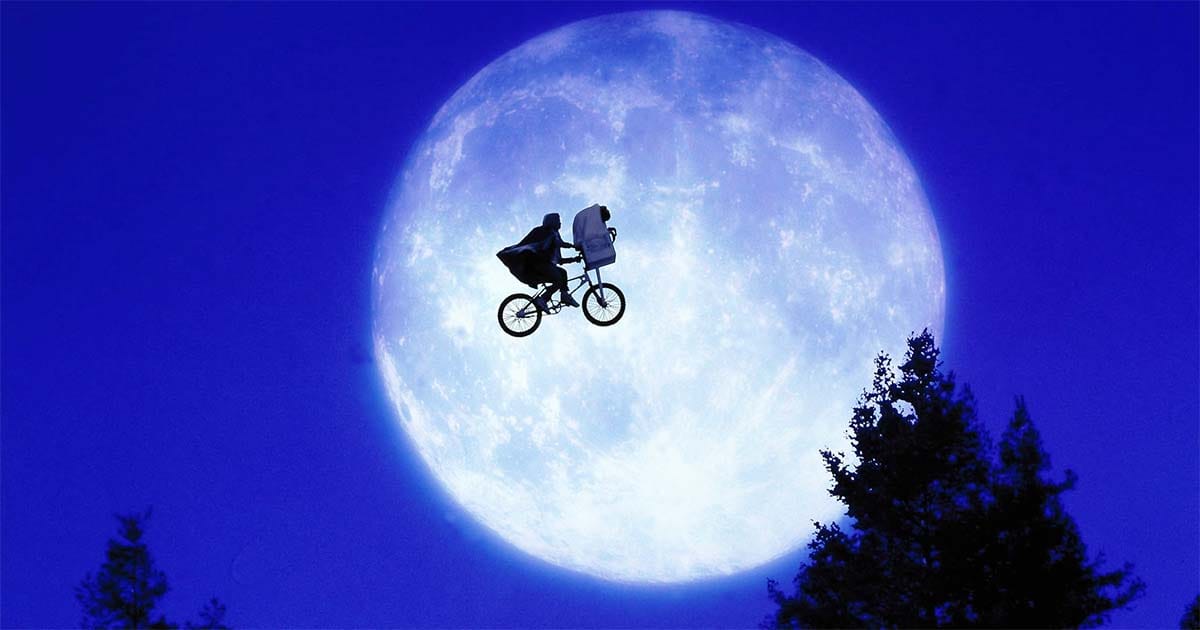A Boy, a Bike, and an Extra-Terrestrial
How a stranded alien and a suburban boy reshaped science fiction storytelling. Plus, the moment E.T. turned tears into box office history and three behind-the-scenes trivia gems.

This Week in Classic Science Fiction – E.T. Landed and Changed Everything
On June 11, 1982, "E.T. the Extra-Terrestrial" opened in theaters and redefined what a science fiction movie could be. Where earlier films often portrayed aliens as conquerors or monsters, "E.T." gave audiences a stranded botanist with luminous eyes and a glowing heart. It wasn't about invasion—it was about friendship.
Directed by Steven Spielberg and written by Melissa Mathison, "E.T." took a simple premise—a boy hiding an alien in his backyard—and made it resonate worldwide. It was intimate and epic at once, a story about broken families, government paranoia, and childhood wonder. More than any spacecraft or laser gun, it was the quiet scenes between Elliott and E.T. that left audiences stunned.
The film became a cultural event. It earned over $700 million worldwide, surpassing "Star Wars" to become the highest-grossing film at the time. Kids rode bikes with dreams of flying. Parents wept. Even critics who normally scorned science fiction praised it.
"E.T." didn't just phone home. He made science fiction feel like home—and proved that a story about an alien could be, at heart, a story about us.
Sponsor: Probably Just Swamp Gas

Sure, it looked like a UFO—but Grandpa swears it was Venus reflecting off a weather balloon.
Our Alien Campfire Myth tee celebrates the timeless tradition of explaining away the unexplainable. Whether you believe in little green men or just like a good yarn, this shirt is soft, comfortable, and 100% government-denied.
The Alien Reimagined
In earlier films, even so-called benevolent aliens arrived as moral judges or superior beings.
Klaatu in "The Day the Earth Stood Still" warned Earth of its failings. The Monolith in "2001: A Space Odyssey" uplifted humanity, but remained unknowable. These aliens may not have been villains, but they weren't relatable.
E.T., by contrast, is a creature of instinct and emotion. He is confused, frightened, and curious. He does not speak in riddles or warnings. He learns English like a child. His powers—healing wounds, reviving plants—are gentle, even miraculous. In short, he is vulnerable. That vulnerability forces the viewer to care.
The shift was simple, but profound. The alien was no longer an outsider to fear. He was someone to help.
Childhood as a Point of View
One of the film's greatest strengths is its choice of perspective. "E.T." is told through the eyes of children. Spielberg often shoots at their level, framing adults from the waist down or keeping them in shadow. The viewer experiences the story as Elliott does—with wonder, confusion, and unfiltered emotion.
The use of children is more than a stylistic decision. It creates a moral clarity. The kids don't ask what E.T. can do for them. They see someone in need and respond with loyalty and love. This is especially true of Elliott, who shares a bond with E.T. that transcends language.
The film's emotional peaks—E.T.'s illness, Elliott's grief, and the final goodbye—are powerful because they feel true to childhood. There is no cynicism here. No irony. Just love and loss.

Suburbia as a Science Fiction Setting
"E.T." is not set aboard a starship or on a distant planet. It takes place in a California subdivision. This choice grounds the film. Science fiction had rarely visited cul-de-sacs before Spielberg. But by placing the extraordinary in the ordinary, he made the genre feel more immediate.
In this environment, flashlights become searchlights. Government agents become giants. A simple bicycle can become a spacecraft. The film turns familiar spaces into something mythic without ever leaving Earth.
More importantly, suburbia represents a kind of broken American ideal. Elliott's father is gone. His mother is overwhelmed. The family is piecing itself together. And it is in that fragile space that the alien arrives—not to destroy, but to heal.
A Reflection of Faith
There are quiet religious overtones in "E.T." He heals wounds with a touch. He dies and returns. He ascends into the sky. Spielberg never draws direct lines, but the imagery is unmistakable. In a decade increasingly shaped by cynicism, "E.T." offered a spiritual counterpoint.
To a viewer disillusioned with modern storytelling, this theme still resonates. The film suggests that goodness is real. That innocence matters. That there is power in simple acts of kindness. Few modern science fiction films, with their grim dystopias and digital spectacle, aim so high or reach so deeply.
The Legacy of a Friend
The success of "E.T." sparked imitators, but few captured its tone. Films like "Flight of the Navigator" or "Mac and Me" tried to duplicate the formula, usually without the heart. Later attempts at friendly aliens—like "Starman" or "The Iron Giant"—found modest success, but never quite matched the cultural impact.
Over time, science fiction returned to darker visions. Aliens became threats again—in "Independence Day," in "Signs," in "War of the Worlds." The visitor from the stars was once more a symbol of chaos and fear.
And yet "E.T." remains. Its imagery endures. Its message still lands. It is a reminder that science fiction is not just about the strange or the spectacular—it's about what those things reveal in us.
When we look back on the golden age of cinematic science fiction, we remember the explosions, the robots, the battles. But we also remember a small creature in a red hoodie, reaching out with a glowing finger, and a boy who said goodbye.
Not with fear. But with love.
"E.T. the Extra-Terrestrial" Trivia
- Henry Thomas secured the role of Elliott by crying during his audition. Spielberg was reportedly so moved that he hired Thomas on the spot.
- The film was shot mainly in chronological order; an unusual approach meant to help the child actors experience the story as their characters would have.
- The original E.T. puppet was created by Italian special effects artist Carlo Rambaldi, who also designed the alien in "Close Encounters of the Third Kind."

